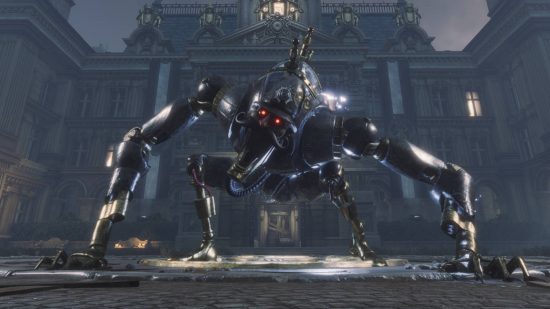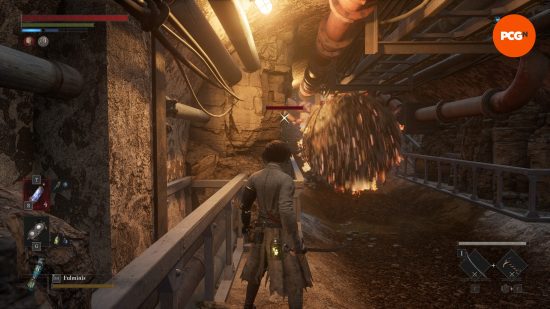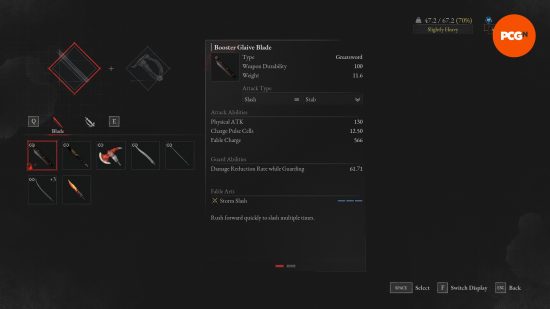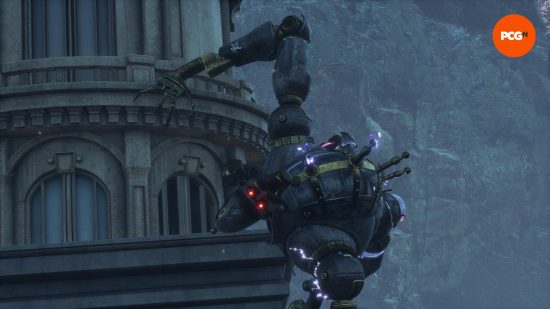Our Verdict
While at first glance Lies of P might seem like ‘Bloodborne at home,’ Round8 Studio’s clockwork adventure writes its own unique story, filled to bursting with expansive Steampunk environments and defined by its well-balanced combat. In some cases, though, it gets a little too clever for its own good, tying itself up in opaque systems.
We all saw Lies of P and went ‘that looks familiar.’ No, I’m not talking about the Pinocchio storyline but the fact that, at first glance, it’s very reminiscent of FromSoftware’s Bloodborne, one of the best soulslike RPG games ever made. While my immediate concern was that this would just be a ‘Bloodborne at home’ situation, Lies of P shakes itself free of its inspiration’s strings with its expansive level design and innovative systems – but sometimes spins a few too many plates for its own good.
You’re thrust into the rather snazzy shoes of Pinocchio (who in this world looks very much like Timothée Chalamet, just saying), who sits lifeless in the carriage of an old, decommissioned steam train. The premise: the city of Krat needs saving from an army of maniacal puppets, who run rampant through its disease-ridden streets. Your taskmaster is a mysterious young woman, Sophia, who bends Ergo (or life essence) to her will. As you battle through mechanical menace after mechanical menace, you find her hanging out in the lobby of the once-proud Hotel Krat, which is quite the spectacle in itself. It’s here that Pinocchio’s new adventure really begins.

Krat, while clearly a prosperous metropolis in its day, has fallen on some pretty hard times. The streets are soaked in grime and oil, with long-dead bodies littering the cobblestones, decaying into the stonework. The city’s industrial heart, Vengini Works, is now a deathtrap complete with a Crash Bandicoot-style boulder that you need to dodge – Krat is spectacular in its sorrowful splendor.
Sadly, the city is let down by its still-surviving, oddly glossy inhabitants. While there are stylistic flourishes aplenty, like during boss battles where your mechanical nemeses shriek at you in distorted text Pinocchio can only half read, because he’s only half puppet, the human characters are vaguely upsetting to look at. Your resident weaponsmith Eugénie stares into your soul with lifeless eyes, no emotion on her glazed, somewhat blurry face. She’s one of the creepiest things I experienced in Krat, and I’m terrified of puppets and dolls. Couple that with some hit-and-miss voice acting, and Lies of P’s world feels almost tinny despite its evocative backdrop.
While the story lacks some pizazz, the scale and warped beauty of Krat go some way to make up for it. The aforementioned Vengini Works showcases the game’s impressive variety, taking you from a factory floor to a subterranean network of pipes that house torrents of green, corrupted water. Further on in the level, the factory grows increasingly industrial, with blaring red sirens and yellow and black hazard warnings ramping up the tension ahead of the inevitable boss fight. While Krat is sprawling, what’s perhaps most impressive is how it’s all woven together, with levels looping back on one another with a variety of different shortcuts and twisting, interconnected passages. There are very few loading screens to interrupt your traversal, too, meaning that each zone feels well-constructed and expansive, encouraging more exploration over a mad rush from point A to B.
There are also a whole lot of bosses lurking around, patrolling the streets of Krat – in fact, we have a list of all the Lies of P bosses. They come in myriad shapes and sizes but generally scale well as you progress through the story. Each has its own unique mechanics – Mad Donkey is straight out of Bloodborne with his saw-like glaive, whereas the optional and recurring Puppet of the Future boss is a huge, cumbersome menace that, unfortunately, often takes up residence in pools of health-corroding gunk.
These encounters are hard but seldom overly punishing, and you’ll rarely feel like you’ve hit a brick wall simply because you’ve equipped one of the best Lies of P weapons. I beat the Parade Master with my trusty cutlass, then Mad Donkey with the rapier, whereas my colleague beat everything comfortably with the hulking Frozen Feast greatsword. Balance is essential in any game, but it’s at the core of soulslikes. Lies of P manages to tread that line across a plethora of different bosses, and it’s genuinely impressive.
What is disappointing, though, is that some of the game’s coolest weapons feel a bit pointless. While the core rapier, greatsword, and cutlass are great go-to’s, I eventually acquired an awesome-looking flaming dagger, as well as a huge glaive that menacingly spits sparks when you charge its heavy attack. Having immediately wanted to try out both, I realized that the dagger’s fire damage is pretty useless against puppets (unless you want to battle the huge dual-shield tank enemy on Vengini Works for an hour like I did) and that the amount of stamina required to use the glaive means it’s only useful in very select circumstances.
The plus is that you can mix and match different weapon parts, combining them into one ‘super-weapon.’ It’s a feature that’s absent in FromSoftware’s games – you can change the weapon’s ‘mode’ in Bloodborne, of course, but this goes one step further. I traded out the handle on my cutlass for the aforementioned dagger’s handle, making the weapon a bit quicker. It’s not a feature you’ll often use during the early stages of the game, but as you amass more weapons it becomes fairly essential to your leveling experience.
Resources are also key to upgrading your weapons and Legion Arms – Pinocchio’s interchangeable mechanical arm that functions as a secondary weapon. While they’re relatively plentiful at the start of the game, as you progress you’ll gather more specialized equipment, which naturally requires harder-to-find upgrade materials to keep fresh. Of course, improving your gear will help you in the battle for Krat’s liberation, but again it does feel like skill will get you further than an uber-sharp blade alone. The game, at its core, rewards patience. A single misstep, a surge of greed, and you’re dead.
But where the weapon dismantling system shines, others pale by comparison. There are several features here that just aren’t well explained. Humanity is a prime example. As per the Lies of P Twitter, “you gain Humanity points for lying throughout your quests in the game. Depending on how many Humanity points you’ve racked up, you’ll witness different endings to Pinocchio’s story.” Other than changing the ending, however, it seems to have no other bearing on the story.
Similarly, when you lie, you’re met with a message that says ‘your springs are reacting,’ but there don’t seem to be any negative consequences for doing so. It would be interesting to see Pinocchio take penalties to his speed and mobility as his springs warp. Sure, it doesn’t need to be as overt as Fable where you grow more handsome or ugly depending on your alignment, but given that it’s a soulslike, where precision is the name of the game, penalties for your decisions – no matter how small – could have very real implications, and that’s a system that could get really interesting.
It’s also frustrating that you have to return to Hotel Krat whenever you wish to upgrade your character, even if this does present the opportunity to pop on a collectible record from time to time, which also has some bearing on Pinocchio’s aforementioned humanity.
Additionally, I find some of the game’s translations slightly wordy, meaning I’ve caught myself re-reading things once or twice before fully getting to grips with it. It’s nothing major, sure, but things do get a little confusing – especially given there’s so much to keep up with.
But that’s the thing about Lies of P: I want to keep up with the action. Despite its graphical and systemic flaws, I’ve been entranced by Krat and its somewhat shiny people. Round8 Studio’s world has captivated me, and the fact that its difficulty curve is fair and doesn’t present punishment after punishment makes me feel like I’m actually progressing instead of constantly running the same boss on repeat.
Bloodborne doesn’t pull the strings on this Pinocchio: Lies of P is its own, very real game. So I ask you, Geppetto’s puppet: for the sake of Krat, will you lie? Or will you simply die?




